Archive for ‘NAPO Conference’ Category
NAPO 2010 Conference Expo Recap #3: Keep Your Data (and Not Your Head) in the Clouds
In the last two weeks, we discussed some of the stars of the NAPO 2010 Expo, both for gathering and safekeeping paper files and for improving filing productivity. Today, we’ll go a little higher tech and explore some new digital offerings just introduced.

LeeLogic has created two suites of digital applications to keep information organized “in the cloud”, meaning that data is stored and manipulated in a web-based (rather than software-based) environment, working equally well on PCs and Macs. MobilLogic is for business use and StuffLogic organizes personal data.
MobilLogic’s digital indexing and storage system creates a hierarchy of information based on how businesses already categorize. It was designed by a professional organizer to make electronic files, scans, links and other digital information, as well as hard copy information, accessible and retrievable via one simplified, searchable web-based system.
MobilLogic uses a standardized numeric filing system with keyword-based identification. New files are assigned a number/name, but users also get to select keywords that will best help them quickly search for and retrieve the exact item…and learn its location. When in search mode, the system even highlights keywords to ease identification, and users can save searches to provide one-click access in the future — that’s great for when you have a file you need just infrequently enough that you might have had to take a few stabs to recall your keywords.
Many businesses use both digital and paper documents, so MobilLogic works with both — you don’t have to scan or upload everything in order to know where things are. Users can select which files to upload into the system, but because the information about each file is documented (even if it’s not living on the MobilLogic server), you can still click-through MobilLogic directly to the electronic file, whether it’s housed on your computer, your company’s network, or living as a web-based file. For non-digital documents, the system will identify locations based on what you’ve previously told it. (So don’t move stuff without telling the system!)
Because MobilLogic is web-based, users can access the system and search, view, revise or add from anywhere. The system has user-level security, from departmental to individual, ensuring that everyone who needs (and has a right) to access material can do so. It’s even HIPAA compliant.
So, some departments or employees can have full admittance, but you can restrict access to others who lack the James Bond-esque, eyes-only, need-to-know clearance. The security protocols and cloud-based system, combined with four-times-daily backups of MobilLogic’s multiple server locations, mean that companies need not worry about disgruntled former employees wreaking havoc, computer crashes destroying the system or the inability of new employees to access a former employee’s essential files. Because backups can be set for various retention periods, you can restore data from last week, or hit reset to time travel to anywhere up to when you first began using the system.
MobilLogic doesn’t just organize information for storage and retrieval. You can set up email reminders and text alerts associated with individual document-related tasks or deadlines, so nothing falls through the cracks.
MobilLogic has a one-time $25 set up fee, plus a $25/month/license fee, up to four users, with discounted monthly fees the more concurrent user licenses you add. If only three people need access most of the time, but you have a virtual assistant or part-time employee who needs access certain days per month (or quarter, or whatever), you only pay for the number of people using the system at any given time, and you can change the number of licenses you’re using — up to once per day.
StuffLogic operates just like MobilLogic, keeping track of personal files and possessions (digital and hard copy), from electronic files and bookmarks, to magazines, hobby material and those boxes of memorabilia in the hall closet. Just as with the business version, you can set email or text reminders based on tasks or deadlines related to the stuff you’ve “filed” and might later want to access. It’s priced at $20/month for a single license fee, or $25/month/concurrent licenses for the Premium plan, which includes additional security and administrative features.

CareBinders is a personal recordkeeping software package — the digital equivalent of the boxing-it-up method we discussed two weeks ago to collect and track the data for all elements of your life. For each category, the software has specially-created screens to trigger your recall and help you identify exactly what data you need to store. Input information directly, import it from other programs, or scan and attach photos and digital versions of vital documents. For example:
Financial–Account numbers and data for banks, credit cards, brokerage houses, and insurance policies; Descriptions/photographs/videos of tangible assets and financial assets; Contracts and other legal documents; Inventories of valuable collections; Data regarding subscriptions and ongoing payment plans.
The system can then generate a data locator report, which aggregates all the information you’ve input into the CareBinders system (with or without the dollar valuations) so that you can safekeep a copy for loved ones, in case anything happens to you, or place in your safe deposit box to use in case of theft or disaster in your home.
Medical–The system prompts you to report every medical detail, including allergies, diagnoses and medical/prescription histories, medical practitioner contact information and dates/notes from doctor visits, test results, and more.
Personal–In one sitting, you can enter all the vital details of your life, so you (or someone acting on your behalf) can gather information necessary on everything about you: Educational and employment history; contact information for residential service providers (like that guy who stopped the heat pump from making that scary noise that one time), pet information, groups and affiliations, volunteer projects, passwords, all your personal contacts (including how you know them and from where), awards and achievements, etc.
Fun–CareBinders has special modules to keep track of whatever you collect or want to remember and track, whether it’s tangible items like baseball cards, DVDs, wine or stamps, or plans for or memorabilia from wedding, parties, vacations or holidays.
Once you’ve entered all of your data (and reminded yourself to create updates on a regular basis), the CareBinders system works in a few ways. First, it lets you get everything out of your head and into the system, so you can stop wracking your brain to remember a company’s or contact’s exact name, or where you put the new insurance policy.
Second, once you enter something, the CareBinders system populates other screens with the data you need, so you don’t have to enter the same darned information over and over on multiple screens. Once you’ve told the system something, it knows where to put that data in other files or documents. So, if your family moves, you don’t have to enter the new address for the records for yourself AND your spouse AND Jimmy, Johnny, Jessica and Janine (whoever those kids are)…unless you aren’t all moving to the same place.
Third, the system saves the data you enter and manipulates it to create new documents, in addition to the document locator, like a:
–Medical Intake Form you can bring to a doctor’s visit so you (or someone helping you) can fill in everything from blood type to insurance IDs to medical history)
–Asset/Inventory lists to help your insurance salesperson or claims adjuster complete your paperwork more quickly
–Emergency medical wallet card
–Pet profile, with demographic data and an immunization and medical history
–Resume
–“Grab & Go” reports you’ll need if there’s a natural disaster and you must leave home quickly
A CareBinders Master license runs $199 for downloadable software. For $5 more, you get the download and a program CD, suitable for gifting. CareBinders offers volume discounts ranging from 15% for purchases of 4-5 copies, up to 35% discounts for large volume purchases.

LegacyIt provides a digital opportunity to collect the elements of your life history in a simple, fun, interactive way. While LeeLogic’s suites are designed to keep your data easily organized and retrievable from the cloud, and CareBinders keeps your digital information safe and organized for practical reasons, LegacyIt is all about preserving the impractical…the sentimental…the ineffable qualities that make you who you are. Instead of tracking the data of your life: the numbers, the assets, the diagnoses – LegacyIt helps you gather the meaningful experiences of your life to share with others.
LegacyIt involves three steps:
1) Preserve your legacy by digitizing and preserving your memories in one collective space. Once you set up your account and download Microsoft Silverlight (at no cost), you can upload your existing digital photos and scan your traditional photos (or negatives) to make them ready for uploading.
If you haven’t yet, or only recently, upgraded to digital photos and can’t bear the thought of scanning forty or fifty (or 90!) years of your life in photographs, LegacyIt has partnered with Digital Pickle, a photo and video restoration service. Ship them your shoeboxes of personal archives, and they’ll scan your photos, slides, or negatives for you.
2) Build your legacy in two ways:
First, organize your photos by category — for example, you can create an event and gather together all of the photos and commentary about a particular family vacation.
Second, record the detailed history behind each photo, using LegacyIt’s audio, video and text features. For example, you can use text to tell the story on the “reverse” side of any digital photo, so it’s just like when people used to write on the backs of their snapshots (before we all knew that was bad for the photographs). Or, use the audio or video features to share the anecdotes related to the pictures. You might get creative and let others, like grandchildren or old friends, interview you so that the story has a more conversational feel.
3) Share your legacy in a secure environment and create Legacy Trees, which grant permission to individuals to view what you’ve created. LegacyIt has taken on many of the qualities of popular social networking sites to create privacy settings so that you can share (or restrict) access to individual photos and stories. You select who gets to see and hear which elements of your legacy…so that if you only want one grandchild to know that she’s your favorite, you can do it!
Create public and private “sharing galleries” of photos, write journal entries and guide others to share their own legacy stories. LegacyIt has a module to design your bucket list, identifying all the things you’d like to achieve in your lifetime, and then you can add photos of these accomplishments as you attain them. LegacyIt even gives a nod to the other, more practical, data organization systems with a secure place to store personal and financial data, passwords and other vital information.
LegacyIt has four pricing plans, with monthly fees ranging from $5-$25/month and 16-20% discounts for annual, rather than monthly, billing. Every plan includes access to all photo, audio, video and text features and enhanced security, but pricing determines how number of users per account and the amount of storage granted. The Basic plan allows only two users, the Deluxe allows three and the Premium and Premium Plus package allows up to five users; at the Basic level, accounts gets 2 GB of storage, while Deluxe plans get 5 GB, Premium 10 GB and Premium Plus plans include 20 GB of storage.
LegacyIt is an intriguing blend of social networking and digital memorabilia storage. For families with plethora of history but a dearth of technological know-how, this all-inclusive training-wheels approach can be a boon. However, as with all cloud computing options, Paper Doll is concerned regarding what happens long-term. If you help Grandma upload photos and record a detailed history, can your family afford to keep paying the fees in perpetuity? LegacyIt says you can cancel your membership at any time, but suggests retrieving your data within 60 days. Long term, it would be wise to appoint a tech-savvy family member as family archivist and account beneficiary, to oversee the process and truly maintain your legacy.
NAPO 2010 Conference Expo Recap #2: Innovations in Office Paper Organization
Last week, Paper Doll reviewed some of the products at the NAPO 2010 Conference Expo designed to help you gather and box up your important papers for organized safekeeping. Today, we’re going to review some solutions specifically for filing, whether for your business or home office.
It’s not uncommon for major dichotomies (PC vs. Mac, Dymo vs. Brother) to spring up in the organizing world, just as we see in the real world (Ford vs. Chevy, Yankees vs. well, everybody else). It might seem that there are no two adversaries looming as large as Smead vs. Esselte’s Pendaflex. For example, in last year’s post-NAPO Conference Expo recap, Smead’s Tuff Hanging Folders went head to head with Pendaflex’s Hang Tuff™ (now Sure Hook™) Hanging Folders. However, in the words of the Arbiter in the Opening Ceremonies theme from the musical Chess:
This is not the start of World War III
No political ploys
I think both your constitutions are terrific.
So now you know — be good boys.
We professional organizers love Smead and Pendaflex’s paper management products equally, and we just want them to keep pumping out ever more fabulous product innovations.

No More Tears (boo hoo)…Or Tearing (rrrrrrip!)
The first thing that caught my attention at Smead’s booth was innovative less for what it does than for what it doesn’t do — cause owies.
Files with fasteners keep papers from becoming separated from the folder or associated papers, and maintain proper chronological order for easy reference, but they’re a pain. Paper cuts are the first danger we face when organizing papers, but if your office uses folders with fasteners, common in legal, medical and accounting offices, you know the pain that can sometimes be inflicted by those twist-ties on steroids. They’re cold, sharp and they poke at your skin. They tear the paper, become crinkly after being bent multiple times to add new papers, and can scratch your desktop.
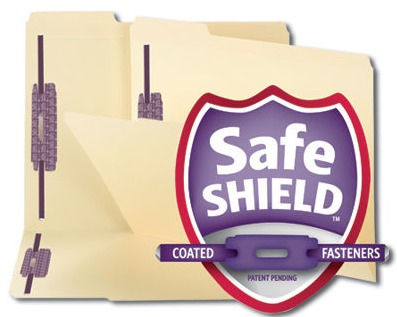
Smead’s coated SafeSHIELD™ Coated Fasteners are being billed as the “feel-good solution for your documents and fingers”. The metal strip fasteners are covered in a smooth, leathery sort of coating to prevent scratching skin and surfaces or tearing papers. I tested a sample, bending and twisting, and though I’m sure the metal strips were crinkly after my abuse, the SafeSHIELD coating kept the fastener smooth and my fingers safe. SafeSHIELD™ fasteners now appear on fastener folders with dividers, end-tab fastener folders with pockets, and various other legal and letter fastener folders.
Organized People Like a Firm Handshake
At first glance, the Easy Grip Pocket looks like every other heavy-duty redrope (reddish-brown, to the rest of us) accordion-edged, Tyvek-enhanced pocket for maintaining thick stacks of papers, reference material or directories. Innovative? I was dubious when Smead’s Julie Hicks pressed me to test it out at the Expo booth.
A regular pocket folder and the Easy Grip stood side-by-side, filled to almost bursting with the same heavy load of documents (and possibly some small bricks, from the feel of it). I reached out with one hand, adjusted my “I’d like a hamburger THIS big” motion to fit the expanse of the opening and attempted to lift it. Because the smooth paper of the pocket folder slipped in my fingers, I had to tighten my grip and put forth more effort with my hair dryer muscle (AKA: biceps).
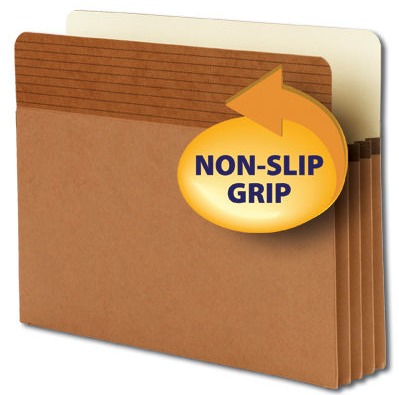
However, when I repeated the process with the Easy Grip, I was delighted that the addition of a non-slip, faintly rubbery, “grippy” texture on the upper portion of the pocket meant that I neither had to squeeze tightly with my hand muscles or strain my thumb or wrist. It’s not exactly magic, but we all know that every little annoyance in our office makes us more likely to become distracted, and less inspired to organize our files.
Easy Grip folders come in letter and legal sizes for 1 3/4″, 3 1/2″, or 5 1/4″ expansion.
The Roar of the Crowd
Stadium-seating movie theaters have become popular in recent years. They’re beloved because you no longer have to fear that the point guard for the high school basketball team will be sitting in front of you at the movies. The graduated, tiered seating makes sure that nothing obscures your view of the screen.
Smead’s Stadium File does for desktop filing what stadium seating does for movie patrons. Too often, our file systems start out methodically organized, with successive folder tabs running left, center, right, left, center, right — until the day you need to add a new folder and end up with a left-tab folder behind another left-tab folder. The more files you have, and the more crowded the are, the less easily you’ll spot the folder you need at a glance, and the more likely you’ll have to let your fingers do the hiking, slogging through the paper equivalent of muddy terrain.
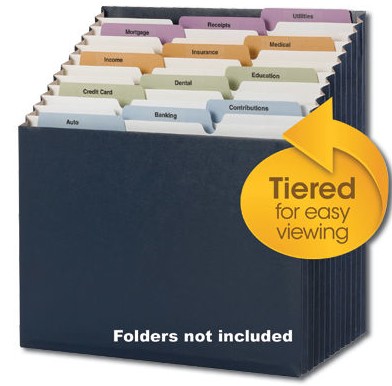
The Stadium File has twelve tiered pockets, holds 900+ sheets of paper, and includes labels for A-Z, Jan-Dec, 1-31, household subject categories (like Auto, Banking, Insurance, etc.) and blanks for customization. It’s accordion-style with fully-lined Tyvek gussets to keep it sturdy, and the two I’ve tested (at the Expo and with a client) managed to stay upright no matter how many papers or files were inserted.
![]()
Me, Myself and I…Organize
Pendaflex’s big 2010 innovation is a new portable filing system, the I*Organize Binder, designed to give the user complete customization control with mix and match filing elements. I’ll admit, I didn’t quite get the appeal at first, as it seems too minimalist for professional use, but after a few hands-on experiments, I see this is no mere Trapper-Keeper!
The system includes two aspects, the binder and the filing tools. The binders, instead of using pockets or rings, rely on a nifty system of “channels” into which other filing elements can easily slide in or out and then click into place. No hole-punching required–just unlock, align the spine of the tools with channel system, slide and lock!
The choice of three binders includes:
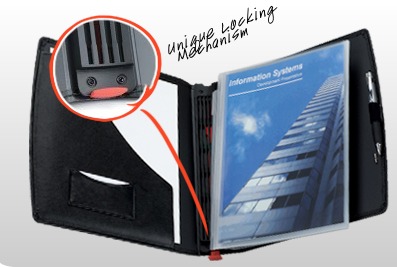
–The Presentation Binder comes in a leatherette finish and has four channels for creating classy presentations.
–The Storage Binder is constructed of durable poly and has eight channels for maximum storage potential.
–The Essential Binder is made of a flexibly poly and has four channels, with a slim design created to fit easily in a backpack.
The filing tools include the following options, all of which slide vertically into a channel on the binder’s interior spine:
Clipboard–for taking notes or following itineraries
Project Pocket–segments papers with three dividers and write/erase tabs
Twin Pocket Folder–allows for protected display of horizontal 11″ x 17″ documents
Envelope–with elastic closure for receipts, business cards and easily lost items
Secure File Folder–has large storage capacity
Display Book–five clear pockets (10 page display)
Media File–holds CDs, DVDs, flash drives and memory cards
Wave Pocket–holds up to 30 easily accessed pages behind a die-cut wave pattern that exposes the upper right portions. 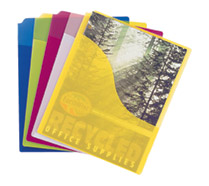
The spine of each filing tool has fold-out channel strips that tuck away when not used with the system’s binder.
Ice Cold Milk and an Oreo Cookie–It’s All About the Double-Stuff!
When organizing paper (a topic obviously close to Paper Doll‘s heart), it’s important to strike a balance and have categories that are neither too broad nor all-encompassing. It does no good for productivity to have a folder that never carries more than one or two sheets, nor another that carries the weight of the world in triplicate.
Sometimes, however, one category of paperwork requires a thick stack of papers and cannot easily be divided into multiple folders based on sub-categories or chronology. In the hanging folder world, there have long been box-bottom folders, sturdy hanging folders designed to hold directories or other heavy-duty contents. With regard to interior file folders, whether manila or colorful, their bottoms (if you’ll pardon the expression) have seen little innovation over the years.

Just about every file folder, whether high-end with paper-cut prevention and fancy design, or overpriced, off-brand packs of five from the drugstore, comes with those two or three ridges near the crease. When a file folder’s girth causes papers to shift upward and threatens to obscure the folder’s label, you can widen a folder’s base by folding down some or all of the ridges, expanding the typical folder’s bottom edge to about three-quarters of an inch.
But what if you have more papers than that? This is when you might need Pendaflex Double-Stuff File Folders. Each high-capacity file folder holds over 250 sheets of paper and is made of sturdy 11 pt. acid-free paper. Unlike how regular folders have the two expandable ridges on the front, such that expansion causes the front of the folder to have a much lower profile than the rear, the Double-Stuff folders have one ridge, each, on the front and rear of the folder, allowing the base to expand up to 1 1/2 inches without sacrificing frontal coverage.
Caution: Wide Load
When asked what products they should purchase in advance of an office organizing session, most professional organizers will make sure their new clients have a robust collection of hanging folders and interior file folders. We usually caution clients to make sure they buy 1/3-cut, or three-tab, file folders. The typical alternative is 1/5 cut, or five-tab, file folders, but five-tabs simply lack enough space to adequately label most file folders with pertinent details.
Certainly, we advise clients to only label folders with pertinent, non-duplicated, specific information. But what happens when the file label needs to be longer than even a 1/3-cut folder can manage? And what happens when a client is averse to abbreviating a name or project title?
There are two common alternatives organizers will employ. The first is to reduce the print size on our labelmakers (or try to hand-print very neat, very small labels). This is unsatisfactory to many clients, as the larger type-face of the printed labels is often a major motivator to stick with the organizing process, and clients with advancing age and/or declining vision find the smaller labels either unreadable or unmotivating.
The second alternative is to carry the label down to a second line. Although this allows for detailed file labeling, if the printed label is large enough to be read clearly, the second line will likely be obscured once papers are put into the folders.
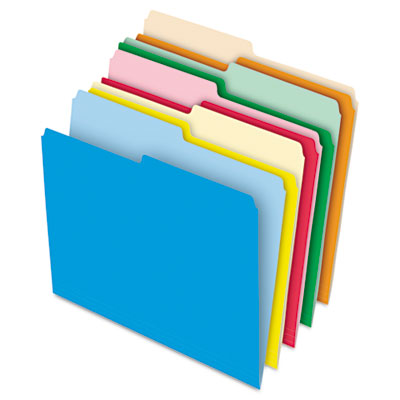
This is where Pendaflex’s Stretch Tab File Folders come to the rescue — the tabs are 50% longer than 1/3 cut tables to increase the visual labeling area. As the colors are matched to traditional multicolor Pendaflex files, the Stretch Tab File Folders seamlessly merge and integrate with the folders already being used. So, if you’re trying to create a folder for Anna Banana Fe-Fi-Fo-Fanna’s Annual Family Reunion, the stretch tabs will work like a stretch limousine, to get you where you want to go — in style.
Both Smead and Pendaflex courted professional organizers with many more wares than can be mentioned in one post. If paper were poker, I could see you Pendaflex’s anti-microbial file folders and raise you Smead’s See File and All-In-One Tax Organizer. If we were ready to rumble, we could have a grudge match of Smead’s Fastab folders and Easy Slide hanging folder tabs against Pendaflex’s Ready-Tab file folders and hanging folder tabs. But the first rule of Fight Club is “Don’t talk about Fight Club”.
I’ll be back next week with a review of some of the digital information solutions from the NAPO Expo.
NAPO 2010 Conference Expo Recap Part 1: Boxing It Up
One week after my return from this year’s conference, whose theme was “Innovate. Connect. Inspire”, I’m still reviewing the notes I took during the presentations of our amazing keynote speakers, Tim Sanders, Gina Schreck and Monica Wofford. I’m also wowed by my colleagues, whether it’s the brilliance of their sessions (particularly those taught by Lauren Halagarda, Scott Roewer, Brandie Kajino and Allison Carter), or the delight of their companionship as we toured Columbus, Ohio’s Short North district in search of the unusual flavors at Jeni’s Ice Cream. Mmmm. Ice cream.
Our 2010 Expo offered another fine selection products for helping make lives easier and more organized. Over the next few posts, I’m eager to share with you some of the paper-related treasures we professional organizers encountered.
Each year, I find that a theme begins to coalesce in the NAPO Expo showcase, and this year, it was all about boxing up your papers, but each had its own twist. This week, we’ll review some of the innovative ways paper (including vital documents, memorabilia and more) are gathered up, collated and preserved for easy access.
Tote That Barge, Lift That Bale (of Papers)

One of my favorite new products came from the Alpha-Omega Collection by KC Streamline Concepts. Yes, at first glance, the main product does look like a typical desktop, open file box. And it is. It’s got a few nice bells and whistles, like the front kangaroo-pocket for a notepad and pen, and dated tickler file inserts (because you know how Paper Doll loves tickler files). The Standard Edition is made of ABS plastic and comes in Licorice, Caramel or Blueberry. The oh-so-classy Executive Edition is made of solid wood in Honey Maple or Cherry stains.
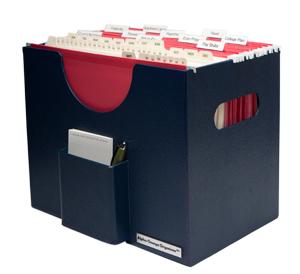

Each carrier comes with the following:
One Biannual Calendar
12 Monthly Folders
31 Daily Folders
1 two-inch Extra-Capacity file folders to hold the monthly and daily folders
10 Action Folders with 10 customizable blank tabs
50 Note Cards
While the boxes are lovely, it’s the Alpha-Omega portable totes that really snapped up my attention! The faux-leather (in Blackberry, Cherry or Coconut) are a huge step up from the hard-side plastic lunchbox-style file totes we usually see. Sure, you can carry a handful of files in a nice portfolio, but if you’ve got a small file crate’s worth of paperwork, this tote is really nifty.

The tote completely zips closed, and has extra long purse-style strap handles that snap together in case you’d prefer a sturdier grip. You can select the faux crocodile accents or opt out, and the interior is nicely lined. The outer pockets wrap all the way around, with the front ones operating like the kangaroo pocket on the Alpha-Omega boxes, and the others yielding ample space for small items. Select the color of the box/case, then pick coordinating hanging file colors.
College Bound? Remember Everything, Kit & Caboodle!
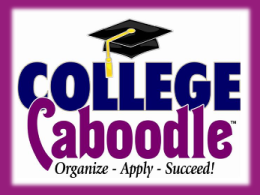
When I wrote my article, Organizing Your College Search And Application Process, the one thing that dismayed me was that for those students or families who were not comfortable creating a Do-It-Yourself filing system, there were few pre-created alternatives. I’m pleased to see that College Caboodle has taken that need seriously.
The College Caboodle is designed to be a centralized organizing system for all of a college-bound student’s VIPs (Very Important Papers), including copies of:
-College Applications
-College Essays
-Letters of Recommendation
-Grade transcripts and copies of standardized test scores
-Community Service Activity Summaries
-Scholarship Applications
-Financial Aid Applications and FAFSA Forms
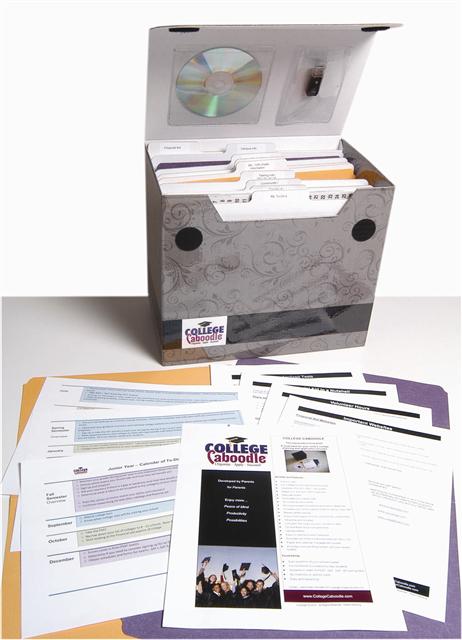
In addition to creating a streamlined filing system for documents, the College Caboodle includes a monthly/quarterly calendar of To-Do items for college aspirants from ninth grade through graduation, easy-to-use forms and checklists to make sure no task is forgotten, pre-labeled folders, resource web sites for application and scholarship assistance, and an instructional CD. The top of the Caboodle box includes plastic pockets for the CD and for a flash drive to maintain essay and application back-up copies. There’s also a built-in tickler system at the front for making sure those tight senior-year deadlines don’t get missed.
The College Caboodle is not inexpensive. However, for parents who have never been through the complex college application process and/or those families who are uncomfortable with organizing the mass of papers and deadlines associated with applying to college, the College Caboodle reassuringly contains all the elements to ensure that no ivy-covered stone goes unturned.
Do Not Pass Go. Collect 200 Report Cards, Photos and Ribbons!
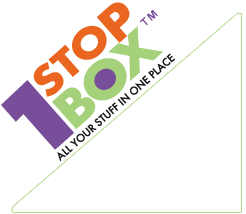
1StopBox has developed a product line for keeping all the memorabilia of life in coordinated kits designed to all fit in a translucent bin of your choosing. The signature product, the Kid’s 1 Stop Box (in designs themed for boys or girls), includes four elements:
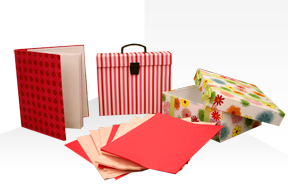
A Removable File Case, which holds all the VIP documents for each child: birth and/or adoption certificate, Social Security card, passport, immunization records, report cards or transcripts, etc.
A File System with nine coordinated expandable files (and pre-printed labels) keeps track of children’s artwork, school and independent projects, and non-VIP papers from nursery school through high school.
A Photo Album contains all of the official photos, including annual school pictures, camp photos, team and individual sports portraits, newspaper and magazine clippings and any other scrapbook-worthy or album-appropriate item.
A Keepsake Box holds three-dimensional memorabilia, like medals and ribbons, small trophies, videos or DVDs.
Future sets will include 1 Stop Boxes for babies, wedding-planning and even pets.
Greeting Your Memories In One Tidy Album
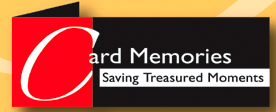
Paper Doll readers know that I’m not particularly eager to encourage you to keep all of the greeting cards you receive. However, if you do want to gather up cards in a collated display, the Greeting Card Keeper Card Album from Card Memories does provide one solution for storing keepsake cards and preserving them safely.
Each greeting card can be inserted into an acid-free Memory Sleeve so one can view both the interior and exterior of any card without having to remove it from the sleeve. The sleeves come in medium or large in order to fit standard sized/shaped greeting cards. Unlike the plastic sheet protectors designed for files or glassine stamp/photo album pages, these are more rigid and durable.
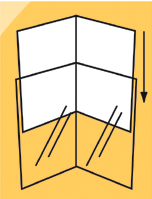
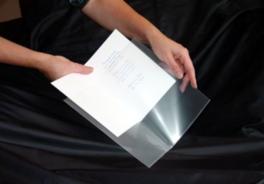
The individual Memory Sleeves fit any three-ring binders with holes punched for a standard 8 1/2″ X 5 1/2″ sheet size (medium) or 9 1/2″ X 6″ sheet size (large). (Binder rings must be spaced 2 3/4″ apart for the medium sleeves and 3 1/2″ apart for the large sleeves.) Each sleeve has a separated, plastic “margin” to prevent binder rings from rubbing against the cards.

Sleeved cards can be sorted by category (birthdays, anniversaries, graduations, etc.) or by date and inserted in any of the company’s various albums. The albums come in medium (8″ X 5″) and large (9 1/4″ X 5 3/4″), and in various styles, including .055 gauge post-consumer recycled plastic milk jugs, in Chili Pepper Red, Cashmere Rose and Stargazer Blue, which come with twenty memory sleeves. Large albums, which include 25 memory sleeves, are available in linen or faux leather, black or red polyethylene plastic, or clear, Raspberry or Blueberry polyproplyene .030 gauge plastic.
The only flaw I can see in the Card Memories line (aside from creating a containment solution that might lead some to keep a larger card collection than is suitable) is that the sleeves are adapted for traditional cards, such as those from Hallmark. Those tall, narrow, tending-towards-silly cards one sees in gift shops and drug stores would not fit these sleeves or albums. However, this is a new product, and one may expect expanded product lines in the future.
Securing Your Vital Interests

One particular item on display at the Expo was not new, but has yet to be mentioned in Paper Doll posts, is Securita’s Vital Records Portavault. Its purpose isn’t merely to collect and collate the very important papers I’m always talking about, but also to make it easy to grab them & go in an emergency. Securita identifies the four basic advantages of the Portavault, in that it helps one:
Identify the vital records and documents one ought to keep in a centralized location. (Yes, Paper Doll has done that for you here and here, for example, but not everyone remembers to take notes!)
Organize the collected essentials in a portable three-ring binder with tabbed sections for individual categories.
Store the documents in acid-free record protectors to preserve readability.
Transport all of the essential papers in one binder, quickly, in case of emergency.
The process for collecting and organizing vital documents in the Portavault is simple. Affix an identifying label to an empty record protector. Then, run off to find the appropriate document(s), and once located, insert into the labeled record protector. Lather. Rinse. Repeat.

The Portavault’s exterior carrying case (with handle and shoulder strap) includes a pouch for storing keys, important cards, flash drives and cash. The Portavault’s interior houses the three-ring binder, guidelines for storing vital records, disaster-planning advice, 60 pre-printed labels identifying important documents, 30 acid-free record protectors, and a glow-in-the-dark identification tag, in case the onset of your emergency takes place at night or when the power is out.
This is just the tip of the Expo iceberg. Please return to Paper Doll for more 2010 NAPO Expo treasures, including the newest in office supply solutions from favorite stalwarts Smead and Pendaflex, and a new eco-friendly calendar that lets you see the big picture (by seeing the forest and saving the trees). We’ll delve into the digital solutions for preserving your vital information and memories and keeping your daily data at your fingertips. We’ll even revisit some electronic options that have upgraded their offerings.
Until then, pardon Paper Doll while I go back to thinking about that amazing Jeni’s ice cream. Mmmmmm.
Final Roundup of NAPO Expo Digital Solutions
Neat was a favorite at past NAPO conferences where they’d displayed their streamlined NeatReceipts hand-held scanners, which looked more like sleek Apple-designed three-hole punches than a powerful productivity devices. Neat stole some serious scanning thunder this year with NeatDesk. NeatDesk is up and running on both Mac and Windows platforms, and I’m only a little embarrassed to say that some of its appeal is because, like George Clooney, it’s so darned pretty!
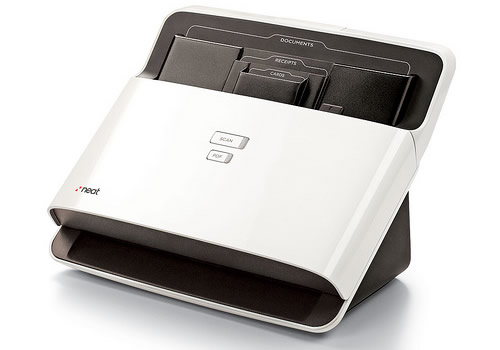
So what else makes NeatDesk so neato?
- It’s a desktop ADF (automatic document feeder) scanner with its own digital filing system.
- It’s high speed, so you can scan business cards, receipts, expense reports, multi-page (unstapled) documents one at a time, or you can (allegedly) throw 50 items at it and it will swallow them up and make sense, putting each in its correct category. (Actually, there are three item types you can scan: documents, receipts and business cards, each with its own slot, and one ought not to try more than 10 of each at a time to prevent NeatDesk from having indigestion. As with most scanners, you wouldn’t want to load it up and walk away…wrinkly paper can cause jams in all kinds of technological devices. Be on hand in case some TLC is needed.)
- Those two little buttons on the front are pretty straightforward: Scan makes it scan and PDF turns what you’re scanning in to a PDF.
- The patented NeatWorks software uses OCR (optical character recognition) and its own “patented parsing technology” to capture data. A visual of what you’ve scanned shows up in your NeatDesk inbox on your computer screen, at which point you can make your own decisions about how you want things categorized.
- The software figures out what kind of item you’ve scanned, so you get back tax records, expense reports, digital contents, searchable PDFs or whatever you need, which you can then file in your own database or export to Microsoft Excel, Quicken, TurboTax or wherever else it needs to go.
NeatDesk is available directly from Neat (Mac-users, scroll way down), at office supply stores, and usually for a price that makes Paper Doll particularly happy at Amazon.com.

Blis (Best Life Information System) wasn’t new at this year’s NAPO Expo, but it did seem to have more fans this time around. Blis bills itself as a “web-based home-life management and information system specifically for on-the-go individuals and families”. But what exactly does that mean?
Blis is a secure, web-based site, so there’s no software to download or install and it’s PC- and Mac-compatible. The site is divided into seven sections. You enter your information and it’s available to you in one place for viewing and printing.
- The calendar has monthly/weekly/daily views, and you can look at events in summary or detail form, just as you’d see on Outlook, iCal or Google Calendar. (Indeed, Blis is compatible with Outlook and iCal, if you want to export events.)
- The planning section has customizable templates, including menu planning, which seems to be what makes this package so popular. As you pull down menu items, the software generates a grocery shopping list. (As Paper Doll‘s idea of menu planning involves choosing between take-out sushi items, she’ll bow to the better judgment of people who actually cook.) Lists available include planning parties, trips, meals, shopping, etc.
- The home section provides a plethora of fill-in lists. There’s a place for tracking emergency as well as regular home-service contacts, identifying the location of emergency supplies, listing home maintenance tasks (when were those smoke detector batteries changed?), and noting who has borrowed items from your family. There’s also a home inventory screen, where you can upload photos and scanned receipts, and a home “updates” page to note remodeling efforts and other aspects of improving your home’s value.
- The health section lets you track health issues for each person in the family, from general overviews, to upcoming appointments to questions you want to ask your healthcare provider. You can even upload test results right into the system.
- The activities section lets you track lists related to personal habits: websites, books you wish to read (or have read), movies you want to rent (or have seen and rated). It also provides spaces for update-able printouts, like babysitter info sheets.
- The My Choice section lets you add miscellaneous lists Blis hasn’t considered so you can customize for your special needs.
- The address book, like the calendar, is compatible with Outlook and iCal.
Blis also has a newsletter, with tips for better using the system and getting advice from professional organizers, and associated products for keeping printed pages in an organized, attractive fashion. The whole system is $125/year, with an $80/year renewal. Yes, I thought “ouch” too, until I thought about prospective users’ needs.
While Blis doesn’t really do anything new, it does it in a unified way. For families who don’t have the time, comfort level or inclination to use or buy and install various software programs, Blis puts it all in one place and does a lot of the thinking so the user need not do so. Plus, for those who not only want it unified but aesthetically-pleasing, Blis has designed an attractive format.
Collectify is a collection management software system focused on being “your own personal curator”. It organizes: initial costs, insurance appraisals, insurance coverage, photographs, copies of auction or sale catalogs, condition ratings, history and provenance…anything that you will ever need to know, quote or prove about your collection. In addition to text, you can also collect audio and video clips (from auctions, interviews with designers and artists, etc.) and photos.
The system offers 33 pre-designed collection templates, but if you collect crocheted hats shaped like dinosaurs or bottle caps with Millard Fillmore’s face on them, you can customize the system for your needs. Collectify offers hundreds of collection-specific data-fields, but you can also customize those (in case you to separate out Millard Fillmore caps produced West of the Mississippi) as well as 40+ report format styles.
Collectify charts your collection’s financial and insurance details as you purchase and sell items, and lets you track the current real-world value in the marketplace. You can even designate in the Beneficiary section whom should get what from your collection…and when. (You still need a legal, notarized will, of course.) Collectify’s written reports can be printed or emailed (to your insurance agent, lawyer, crocheted dinosaur hat-loving nephew…), and a photographic slide show can be emailed or turned into a nifty screen saver.
Collectify costs $149.95 and has a 30-day free trial. Unfortunately, it’s only Windows-compatible. Mac and Linux users must to look elsewhere.

ListPlanIt is the brainchild of Jennifer Tankersley (also known as List Mama), and she understands what I’ve always believed about LIST LOVE — that Lists Organize Virtually Everything–and she’s walking the talk. ListPlanIt is a membership-based site designed for those who live for lists as well as those who need some help in figuring out what goes on which lists to make life easier to lead.
ListPlanIt offers up 400+ lists, browse-able by topic (everything from business planning to time management to moving to travel planning, from student living to holiday planning to organizing clubs to managing your home). Need a template for a sign-in sheet for your book club? It’s there! Want help putting together a budget for an anniversary party? Look no further!
ListPlanIt’s lists and planning pages are mostly in template form, and the type of membership you select determines how/whether you can manipulate the forms. Print Members pay $20/year and can access and print any of the web site’s lists. Download Members pay $30/year and have the added ability to type directly into the forms to add information electronically before downloading or printing. (There’s even a $50/year professional membership for professional organizers wishing to use the lists to help their clients master the art of list-living.) ListPlanIt also offers the L.I.S.T., a weekly opt-in email newsletter, filled with tips and sample lists.

Jibidee was a newcomer to the NAPO Expo, and I’ll admit that I was distracted by its similarity to the goofy catchphrase/sound popularized by Glenn Quagmire on Family Guy. That aside, Jibidee seems to see itself in the same light as Blis–a secure, digital site to keep track of all of the information of life in one central hub, but with a unique visual paradigm.
Jibidee calls its platform a webtop, and is designed to look like a familiar PC or Mac desktop view, with lots of blank space atop a customizable background (like your computer’s wallpaper). Jibidee lets you create new task lists, checklists and notes within categories saved, folder-style (e.g., home, health, school, work, recipes, shopping, etc.), and you can upload scanned documents to be included with your saved pages/sheets.
Open multiple sheets or screen views on one Jibidee webtop, and arrange or tile them at will; by comparison, a typical website only allows you to open multiple windows or tabs, making it hard to see all at once. You can color code the boundaries of the individual sheets to aid your organizing style, and simple drag-and-drop functions let you create sortable mini-spreadsheet checklists. In addition to the self-created lists and screens, Jibidee also has a library of templates.
Jibidee is free to users with up to 20 sheets; after that, it is subscription-based: $18/year, to go ad-free; $18/year for an unlimited number of “sheets”; or $29/year for a combined membership (unlimited sheets with no ads). When asked how Jibidee differs from free sites like GoogleDocs, the reply is that they offer more and greater types of formatting functionality, useful templates and a platform they consider easier to use and more “whimsical” than their competitors.
Frugal Paper Doll imagines that fully utilizing the features would eat up the free 20 sheets quickly, but Jibidee offers a free trial to help you determine if it’s the right platform for you.
If you try Jibidee, or have comments about any of the solutions (for organizing paper and information) displayed at this year’s NAPO Expo, please share your thoughts.
The Digital Stars of the NAPO Expo
Last week, we reviewed the paper-based solutions for organizing information and paper displayed at this year’s NAPO annual conference and expo. Today, we start covering the gems of the digital side of the expo–the software, hardware and services that help us live, if not paperless, at least with a bit less paper.
Pixily was the adorably-named star of the expo. Pixily bills itself as an affordable, secure, easy document management service to help individuals and small businesses get more organized and efficient through the magic of pixelating (OK, digitizing) information and transferring it from paper to neatly-ordered, easily-accessed electronic files.
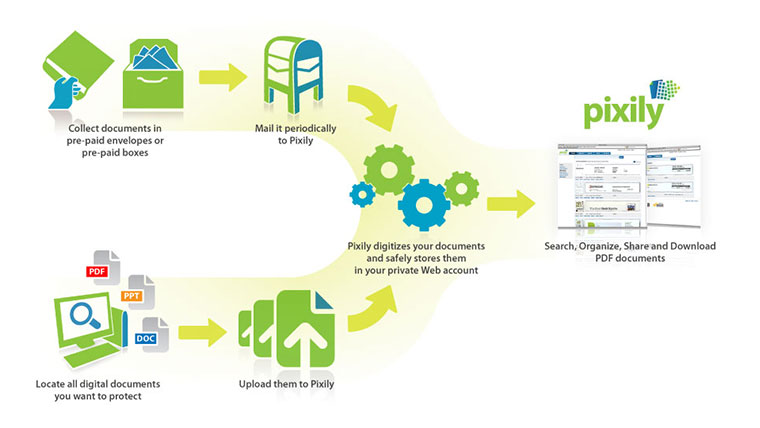
Once in digital form, any data from Grandma’s strudel recipe to illustrations for your patent-pending invention can live securely “in the cloud” of the internet. You can also download anything in your account as a PDF and save it to your own computer or flash drive to ensure you’ll have access whenever…wherever. And, of course, it’s all environmentally friendly.
First, create a Pixily email account: e.g., Paper_Doll@pixilymail.com
Next, choose from four options to get your paper data into the Pixily system:
1. Mail if the idea of hand-scanning your documents is what’s allowed the clutter to pile up in the first place. This method probably saves the most time and effort. Request Pixily’s special “Scanvelopes” via your account; they’re water-and tamper-resistant, pre-paid postage envelopes. Scanvelopes can hold myriad documents, from bills and expense receipts to love notes to your child’s “What I Did Over Summer Vacation” essays.
Skip the staples, smooth the wrinkles, pop in up to 50 sheets and send it via First Class USPS mail. To send documents in bulk, use Pixily’s pre-paid labels (on their boxes or your own) and ship via United Parcel Service. The pre-paid shipping includes return shipping of originals unless you notify Pixily that you don’t want the papers back. Pixily also offers secure shredding services as an option.
Within 3-5 business days of receipt, Pixily’s authorized personnel (right here in the United States) scan and digitize your documents, sending them directly to your private account on Pixily’s secure servers.
2. Upload or Email–If your documents are already in digital form (or once you’ve gotten them that way–see #3), gather them together and send them to Pixily as email attachments or by easily uploading them via Pixily’s website. Pixily supports the following formats: .txt, .html, .pdf., .png, .jpg, .gif and .tif. (M-O-U.S.E. Sorry, but tell me you weren’t humming the Mickey Mouse theme song in your head by that point!) Pixily offers 256-bit encrypted SSL communication, so you can feel secure sending, storing, accessing and retrieving your data.
3. Self Scan–If you aren’t comfy with your documents leaving the house or office, there’s a D-I-Y approach: scan your own documents using your own scanner. Pixily recommends using Fujitsu’s ScanSnap, whose Quick Menu automatically prompts you to select an email address (i.e., your Pixily address!) to which to attach the scanned documents. That’s where option #2 comes in.
4. “Snap it”–It’s a little like Spy vs. Spy, but you can use your camera phone (the system has an iPhone-optimized interface) to snap shots of documents, office whiteboards, etc., and email them directly to your Pixily account.
Once Pixily scans, categorizes and uploads the documents to your account, you or any user whom you authorize can access the files and organize them using Pixily’s digital labeling tools. From there, you can use keyword searches to find the exact documents, and securely share your materials with others.
Pixily offers three pricing plans (Value, Value Plus and Select), starting at just under $15/month for 3000 pages of online storage with one Scanvelope per month.
Pixily seems ideally suited for busy families and small businesses who are long on paper and short on time or resources for getting those documents securely organized in digital form.

ScanDigital was another popular NAPO expo contender. ScanDigital asks:
Yikes, that’s hitting the emotional core, isn’t it? But the truth is that while we all desire our photos to be neatly organized according the rules (in acid-free, lignin-free, archival quality albums or photo boxes), many readers are cringing, knowing that precious memories languish at the bottom of heat- and moisture-exposed cardboard boxes in the garage or attic, in those awful, cellophane-and-adhesive albums that were so popular in the 1980’s, or in closets awaiting us having the time and inclination to start scrapbooking “for real”.
Aging and decay of our photos is a leading source of the “clutter guilt” I encounter as a professional organizer, so it’s not surprising that more and more photo scanning services are marketing to consumers, but ScanDigital has both a 100% Satisfaction Guarantee and keeps all scanned/digitized materials within the United States, which many of their competitors do not.
The steps for getting started with ScanDigital are straightforward. Create an online account and then:
- Select your pricing options: Standard Pricing, at a flat rate per image, or Package Pricing (Starter, Go Digital, Premium or My Life, Digital™), with pricing for blocks of photos/slides/negatives
- Alert ScanDigital whether you’ll be shipping via envelope or box (up to three sizes).
- Select your shipping option (UPS Ground, Next Day Air or 2nd Day Air) or opt to ship the item yourself, at your own cost. For $10, get ScanDigital’s secure DigiPac. Shipped directly to you, DigiPacs include a prepaid return shipping label, secure packaging supplies and detailed instructions.
- Pick your resolution options. For photos, that means “normal quality” (300 dpi for paper photos, or 2000 dpi for slides/negatives) or “highest quality” (600 dpi/paper, 1200 dpi slides/negatives) at an additional 20 cents per scan. For video/film transfer to DVD, the options are for a “premium” digital transfer (suitable for most customers) or “expert” (for professionals).
- Choose your digital storage format (CD, DVD or hard drive).
ScanDigital handles more than photos. They’ll also scan film and negative formats, slides and transparencies, and full photo albums and scrapbooks, as well as film at a price per feet and video (including that long, forgotten standby, BetaMax) at a flat rate per tape.
Assuming you generate a UPS label directly from ScanDigital’s site, you’ll be able to track your materials from your home, through ScanDigital’s departments, and then back to you via their EssentialTracker.
Once ScanDigital gets your items, trained technicians oversee a full process of digital optimization, where they inspect, manually process and quality-review the images, including cropping, rotating and color-correcting, as necessary.
Your originals and the media format you selected are then returned to you, usually within a week, according to ScanDigital. You’ll be able to flip through your originals, enjoy your digitized upgrades and share your free, unlimited online gallery as you desire.
Note: ScanDigital is not inexpensive, and you know that Paper Doll is always price conscious. However, only you can place a price on the value of your time (and memories).
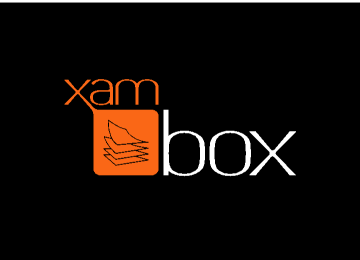
Xambox, from French newcomer Xamance, had an intriguing message to prospective users, based on something they proudly (!) call a chaotic filing system. Indeed, they say:
As shocking as such a statement was to Paper Doll, who lives to sort papers, I was compelled to learn more. How in the world could they advise…no, command…users not to sort?

The basis of the Xambox is a Windows- and Mac-compatible compact scanner with an unusual format. You stack your paper documents in any order in the Xambox Professional scanner and press a button. The Xambox then scans the photos, analyzes the content (including full indexing, color detection, and automatic optical character recognition), stores the digital data for integration with your computer…and then archives the original papers in a box.
Yes, a box. Unsorted, in a box.
When you need to access a document, you perform a keyword search and Xambox displays the digital copy of the appropriate document(s) in PDF form. The twist is that Xambox will also indicate exactly where the hard copy is archived. Xambox says that it will then report “Your invoice is located in box #2, 7th page past the green divider!”
Um. OK. On one hand, it’s nifty to think that the system acts as a Fairy Godorganizer to tell you where the original of any scanned document now lives (i.e., in black and orange Xambox boxes, in your hall closet). On the other hand, this flies in the face of the notion that hard copies, if they must be kept, should be organized and sorted so that they may be retrieved logically, by any authorized person, even when the web is down or the electricity is out.
Xambox definitely has some features of which they’ve a right to be proud. Xambox’s data processing accepts papers in sizes ranging from business cards to legal sized and can correct for vertical or horizontal formatting. It has automatic OCR, in both English and French, and automatic digital copy creation of PDFs.
Their searches definitely seem powerful. Full text searches by keywords are offered, in addition to advanced searching via “Booleans, wild cards, fuzzy searches…” (or so Xambox says…Paper Doll feels pretty fuzzy, herself, reading that). Users can also add meta data to documents and create virtual folders.
Xambox also touts “easy access to original papers”, including archiving and optimum storage conditions in durable boxes. While the boxes may be durable, it doesn’t remove the obligation of the user to store the boxes away from moisture, extreme temperatures or “critters”. Storage capacity of each box is 250 pages, and hard copies are separated by bar-coded dividers to make manual searches more convenient.
Paper Doll is always impressed by the magic of scanning, especially when paired with powerful searching and a user-friendly interface, and Xambox has all that and more. But I’m afraid I just can’t get passed the idea of unsorted, boxed hard copies. What do you think?
The NAPO expo was all about technology this year, so we’ll need one more week to finish up our review and talk about Neat, Blis, Collectify, Jibidee, List Plan It and SaveMyPix.com. Until then, feel free to share your thoughts about these services and products in the comments section.




Follow Me